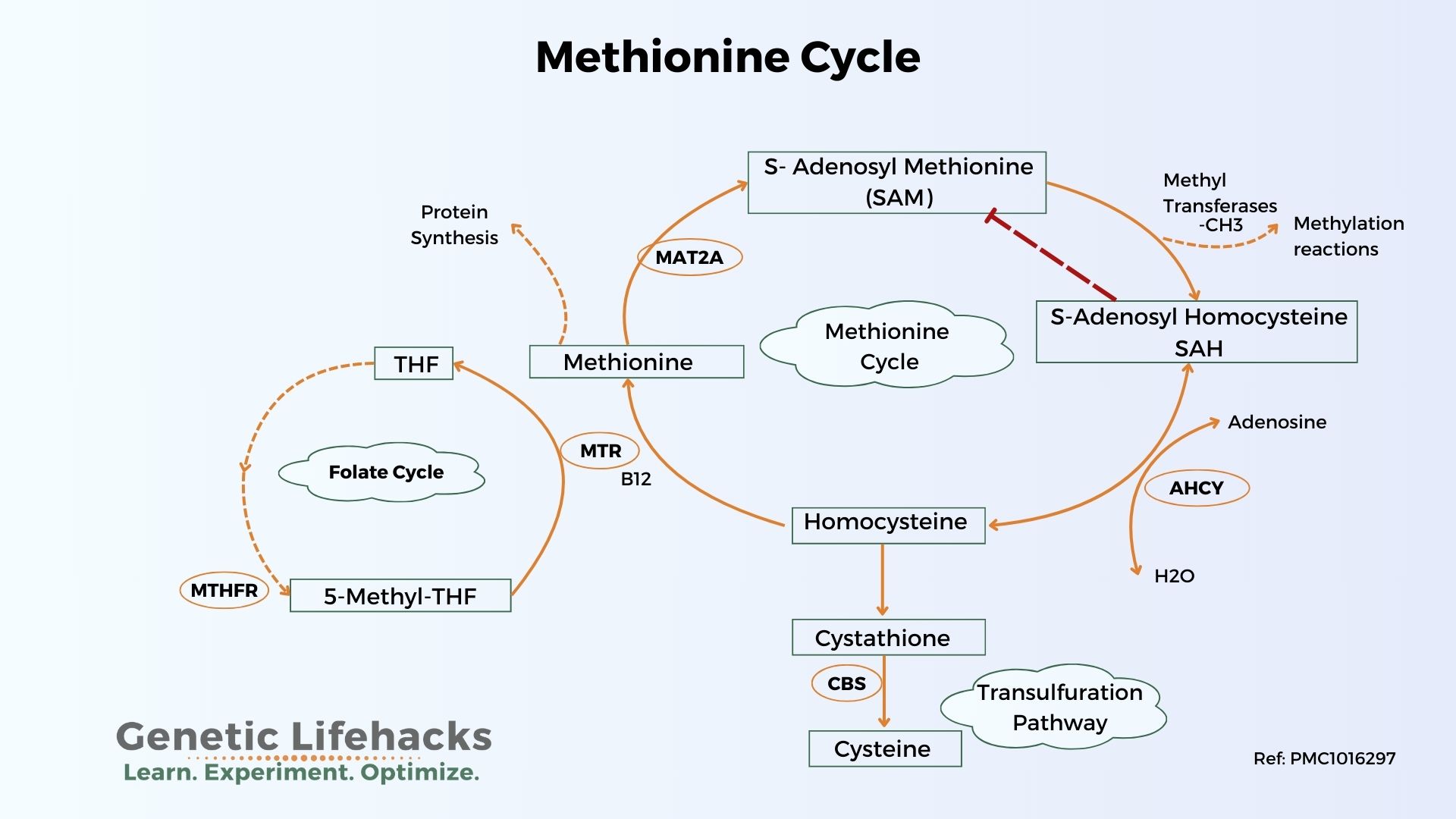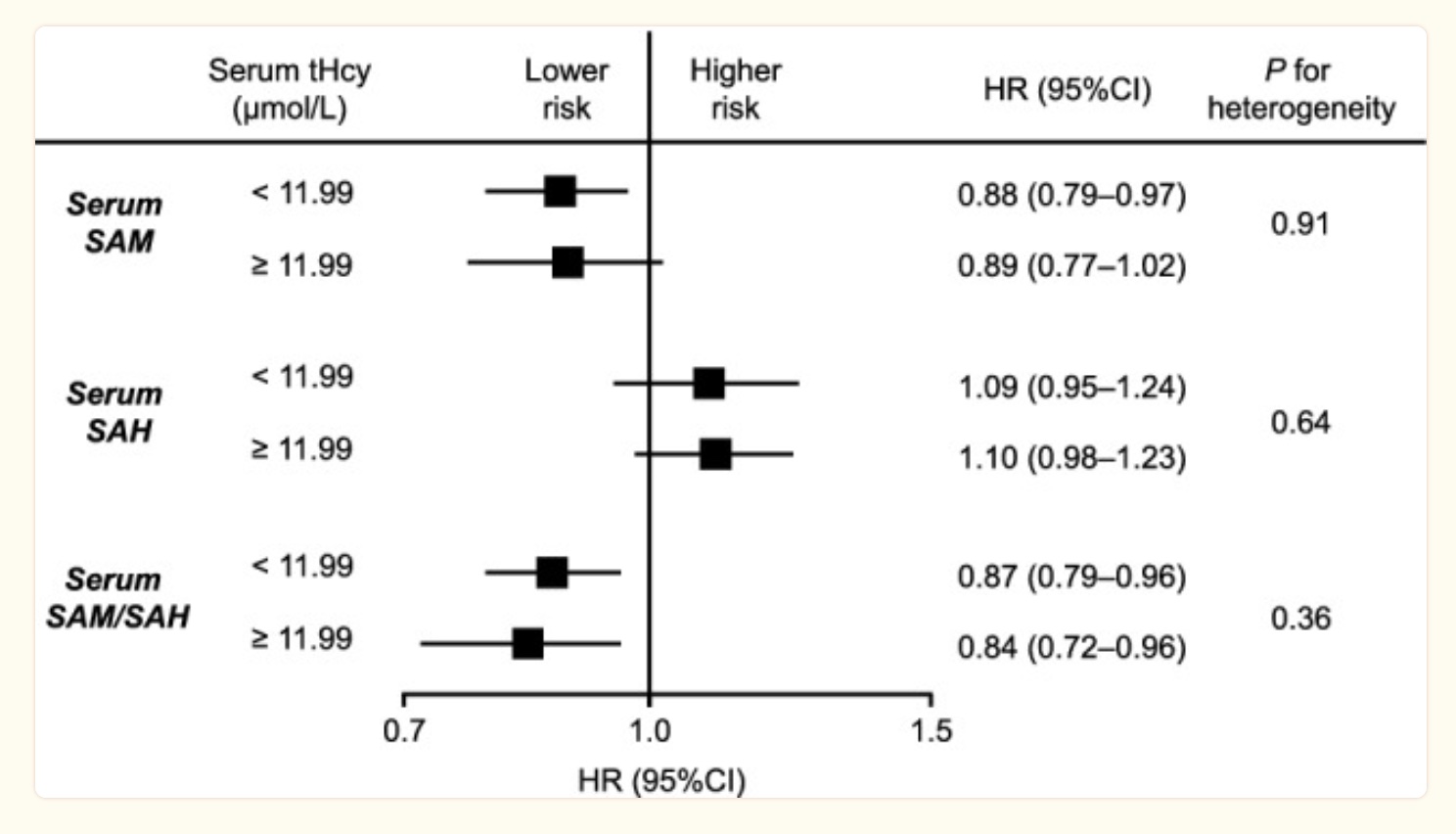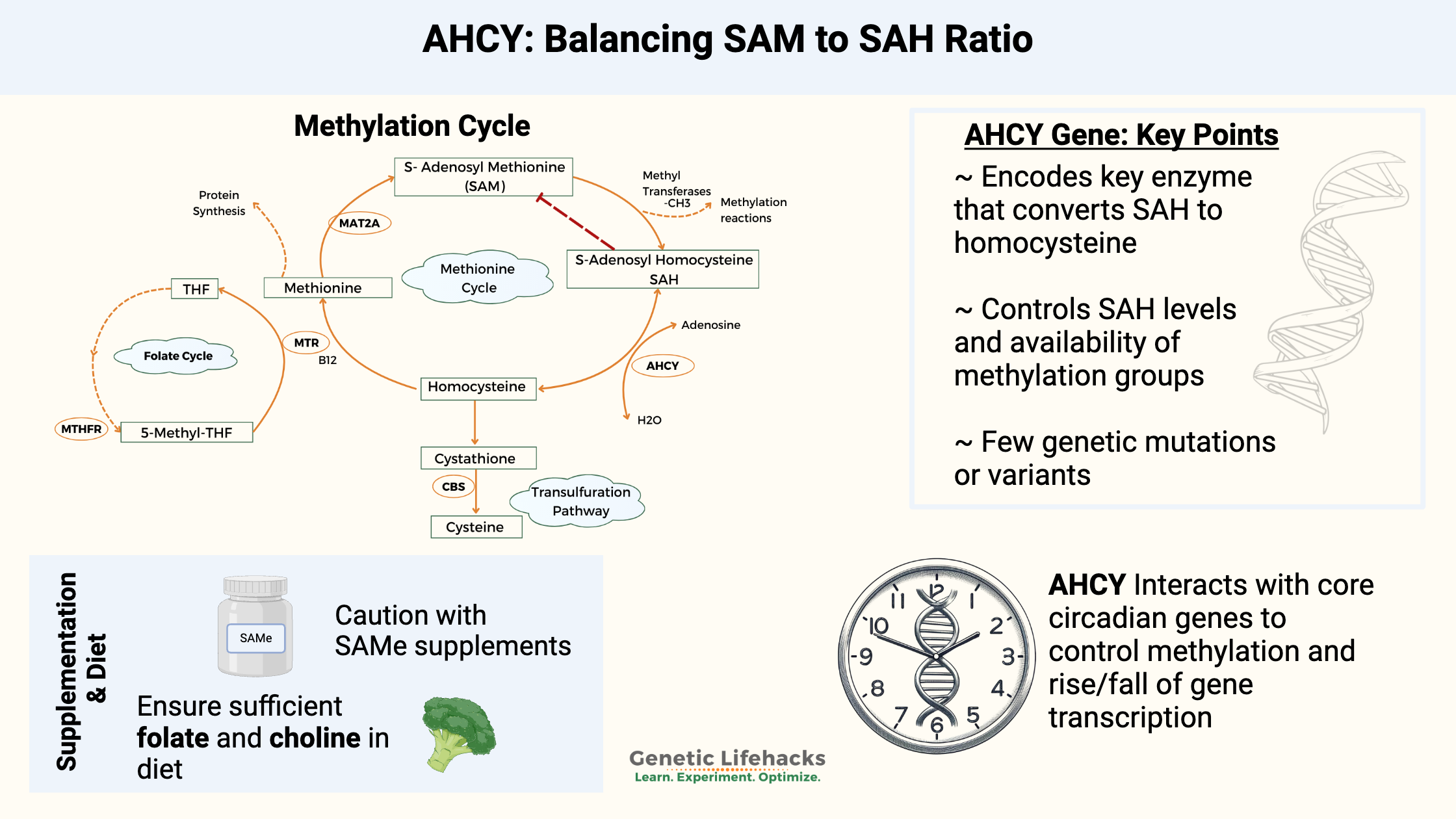Key takeaways:
~ AHCY converts SAH (s-adenosyl homocysteine) to homocysteine.
~ It is key to regulating methylation levels and SAMe levels.
~ AHCY interacts with circadian rhythm genes to regulate DNA methylation throughout the day.
~ Taking SAMe supplements may not effectively alter the SAM/SAH ratio.
AHCY and the regulation of methylation group availability
The methylation cycle produces methyl groups (a carbon atom bonded to three hydrogen atoms) that are used in various cellular reactions and for methylating (turning off) DNA for transcription. Methyl groups are used to convert molecules (e.g. serotonin to melatonin) or in detoxification reactions (e.g. arsenic). And methyl groups are added to nuclear DNA to block transcription of a gene, essentially controlling whether the gene is translated into its protein.
In the methylation cycle, methionine is converted to SAMe (S-adenosyl methionine), which is then converted to SAH (S-adenosyl homocysteine) while donating a methyl group.
SAH is then converted to homocysteine, which can either revert back to methionine or be used to produce cysteine. AHCY is key here as the enzyme that converts SAH (s-adenosyl homocysteine) to homocysteine.
Why is this important?
Methylation, the addition of a CH3 group to another molecule, is integral to many biological processes. SAM (S-adenosylmethionine) is used to transfer a methyl group in these reactions. As one study states, “SAM is the second-most used enzyme substrate after ATP.”[ref]
This diagram shows the methylation cycle and the role that AHCY plays in regulating SAH levels. The red dashed line shows that high SAH levels inhibit SAM.

What is AHCY?
AHCY is the gene that encodes the enzyme adenosylhomocysteinase.
In mammals, AHCY is the only enzyme that can convert SAH to homocysteine, and it can also catalyze the reverse conversion of homocysteine to SAH. This makes it a key enzyme in a fundamental cellular pathway found in all animals.
SAMe and SAH levels are regulated by feedback loops, maintaining the SAM/SAH ratio in balance. AHCY’s ability to catalyze the conversion of homocysteine to SAH is part of this feedback mechanism.[ref]
When SAH levels rise, they inhibit SAMe, leading to decreased methylation.[ref] Global hypomethylation can alter gene expression for many different genes.
SAM to SAH Ratio:
The balance of SAM to SAH is an important marker for methylation and plays a significant role in health and longevity.
The SAM/SAH ratio is tightly regulated by feedback mechanisms. Elevated SAH levels feedback to decrease SAM. Because of this, elevated SAH levels are associated with a low methylation index.
A study in older Japanese adults showed that higher SAM/SAH ratios (higher SAM, lower SAH) were associated with a lower risk of dementia. The study also showed that high SAH levels correlated to increased dementia risk.[ref]

Circadian Rhythm and DNA Methylation
Many cellular processes in the body are controlled by circadian clock genes. These core circadian genes regulate the expression of up to 40% of proteins, causing their levels to rise and fall throughout the day.
DNA methylation in the cell nucleus prevents a gene from being transcribed and translated into a protein. Research shows that AHCY levels integrate with core clock gene levels in order to regulate the SAM/SAH levels and the availability of methyl groups for methylating DNA.[ref]
Extending lifespan:
Methionine restriction is one way researchers increase lifespan in animals, especially for short-lived research animals.
Altering the SAM/SAH ratio yields similar results. In animal studies, downregulating AHCY during aging is linked to extended lifespan. Specifically, downregulating AHCY in the brain and intestines appears to be key in increasing lifespan.[ref][ref]
While downregulation of AHCY in specific tissues in animals increases lifespan, there seems to be trade-offs to overall decreased AHCY levels — at least in humans.
Altered SAH levels:
What happens if SAH is too low or too high?
Atherosclerosis and coronary artery disease:
Low AHCY levels have been shown to increase calcification in coronary arteries. Animal studies specifically show that AHCY is key in this process, with genetic heterozygous knock-out models leading to atherosclerotic calcification.[ref]
Altered in cancerous cells:
Higher levels of SAH are found in colon cancer tumors, and animal studies show that suppressing AHCY in these cells can prevent proliferation.[ref]
Increased homocysteine:
Elevated SAH levels can increase homocysteine levels, which is associated with an increased risk of coronary artery disease, stroke, osteoporosis, and dementia.[ref]
AHCY genetic variants: Are AHCY SNPs important?
An interview on Joe Rogan’s podcast about Dana White’s approach to improving health and longevity brought AHCY into the spotlight. While I won’t comment on other companies’ genetic reports, research indicates that these AHCY variants do not have a statistically significant impact. I have included them below in the genotype report for thoroughness, if you are interested in seeing your genetic variants.
Rare mutations that significantly decrease AHCY levels cause highly increased SAH levels compared to SAMe levels. These rare AHCY mutations lead to significant physical and cognitive developmental impairments from infancy. In other words, mutations here are both rare and very apparent from a young age.[ref]
AHCY is definitely important in health and wellness. It is tightly integrated into cellular health and essential for life. Understanding its function in the methylation cycle is important.
However, like many of the key, essential genes, there just aren’t many variants that significantly impact AHCY function.
Genotype report: AHCY
These first two variants listed here are ones that are included in other genetic reports.
There are no research studies on them and they are considered benign by geneticists. I’ve included them here just for people who are curious about them, based on claims from other genetic report companies.
Check your genetic data for rs41301825 G274A (23andMe v4)
- T/T: rare mutation, considered benign
- C/T: mutation in AHCY, considered benign[ref]
- C/C: typical
Members: Your genotype for rs41301825 is —.
Check your genetic data for rs13043752 C112T (23andme v5)
- A/A: uncommon, considered benign[ref]
- A/G: found in 1% of the population
- G/G: typical
Members: Your genotype for rs13043752 is —.
This is an AHCY variant that may slightly impact function for people who have two copies of the variant.
Check your genetic data for rs819146 (23andMe v5, AncestryDNA):
- T/T: typical
- G/T: typical risk
- G/G: slightly higher relative risk of early-onset ischemic stroke[ref]
Members: Your genotype for rs819146 is —.
This final mutation is rare. Keep in mind that AncestryDNA data is not guaranteed to be clinically accurate, so there is always a possibility of a false positive.
Check your genetic data for rs121918608 Y145C (AncestryDNA)
- C/T: carrier of rare mutation linked to AHCY deficiency[ref][ref]; in animal models, this leads to moderately increased SAH levels and extends lifespan[ref]
- T/T: typical
Members: Your genotype for rs121918608 is —.
Lifehacks:
Caution: SAMe supplements may not be the solution
Many articles on the methylation cycle suggest that taking SAMe supplements can improve the SAM/SAH ratio. This recommendation is based on the idea that increasing SAM will alter the SAM/SAH ratio and provide benefits.
However, with the feedback loops and circadian clock interactions, supplementing with SAMe doesn’t seem to work that way.
Researchers have found that supplementing with SAMe “disrupts biological rhythms.” Instead of increasing methylation, the excess SAMe is broken down into adenine and methylthioadenosine, which actually inhibit methylation.[ref — open access, please read if supplementing with SAMe]
What does this mean that SAMe disrupts biological rhythm?
Well, SAH levels are an integral part of how the circadian clock controls the methylation of DNA to ‘turn off’ genes at certain times of the day. Suddenly adding in a bunch of SAMe from taking a supplement is going to change SAH levels and feedback to alter SAM and circadian rhythm. This is in addition to the excess SAM being shunted to other pathways. [ref]
Testing homocysteine:
Dietary interventions, such as increasing folate-rich foods, may help reduce homocysteine levels and mitigate the effects of altered AHCY levels. You can look at your homocysteine genetic variants to get an idea of whether you’re likely to need more folate or choline in your diet.
However, a blood test is the only way to know your current homocysteine level. If you want to order a homocysteine test on your own, check out this article on ordering lab tests.
Testing SAM/SAH ratio:
Homocysteine: Genetics, High Homocysteine Levels, and Solutions

